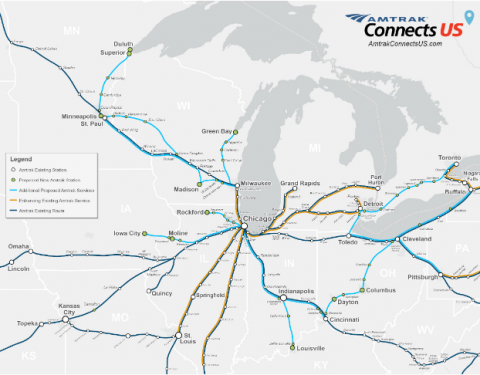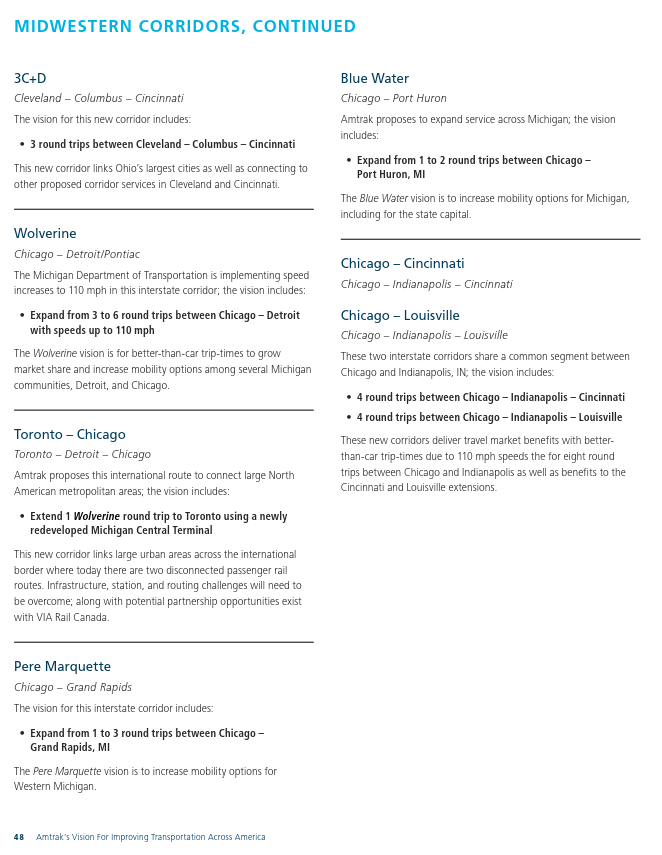Amtrak's "Connects Us" Plan & Michigan

Amtrak has a new plan: Connect Us (PDF, 76 pages).
Amtrak may also be about to receive the largest infusion of funding seen in decades. What do they hope this means for Michigan service?
- Wolverine [Chicago-Detroit] expands frequency from three round trips [per day] to six.
- Pere Marquette [Chicago-Grand Rapids] expands frequency from one round trip [per day] to three.
- Blue Water [Chicago-Port Huron] expands frequency from one round trip [per day] to two.
These service expansions would mean the Chicago-Kalamazoo frequency would be eight round trips per day; that's 16 trains departing from Kalamazoo station every day. Who also wants frequent express bus service between Kalamazoo and Grand Rapids?
Also mentioned, beyond frequency, is reducing the trip time between Grand Rapids and Chicago. As discussed in the old Coast-to-Coast study [PDF, 313 pages] reducing the trip time is both straight-forward [in terms of physical construction required] and probably necessary for any additional service or frequency.
The relevant pages:


Will it happen? Probably not. If Amtrak's funding arrives it will be for capital improvements such as track improvements, new sidings, and perhaps station upgrades. In both state and local governments there is a bright clear line between capital [building things] and operational [running things] funding. All the Michigan services are "state supported" routes; this means the state of Michigan pays the cost of operating the trains. Amtrak's plan for increased frequency on Michigan services basically amounts to Amtrak telling Michigan "hey, you should do this, on your dime". Amtrak likes to say things like:
Thus, Amtrak’s state-supported services require relatively low public funding for the benefits they produce because they cover most of their operating costs from farebox revenues. State Supported routes’ farebox recovery of 66% is double the 33% average for transit services.
That statement is true! Running trains is cheap, safe, actually green/climate-friendly, and cost effective. However, Michigan's Governor Whitmer refers to inter-city rail service as a "legacy" solution. Additionally, the latest Michigan (2023) budget - a product of the new Democratic trifecta - delivered nothing for public transportation. When it comes to transportation the new boss is the same as the old boss. There has been no substantive funding increase to surface transportation in Michigan in decades, adjusted for inflation funding has been declining. An increase from 5 to 11 round trips a day is not going to happen without a paradigm shift in Lansing.
And, will Amtrak's funding arrive?
Here there is both the problem of authorization vs. appropriation and if funding will be continued in the future. The current US House wants to make drastic cuts to Amtrak - and really anything other than roads and guns. So far the Senate Appropriations Committee has gone the other way, providing Amtrak a small increase., but eventually the two sides (House & Senate) have to agree. How infrastructure and investment happens in the United States is a tragically complex process. It isn't over until the shovel is in the ground or the welder has fired up his torch.
Will host railroads agree?
More service to Grand Rapids (the Pere Marquette) will require working with CSX; improving trip times requires investing on CSX property. Adding service to the Blue Water will require the cooperation of the Canadian National railroad. All Michigan services use the Norfolk Southern railroad to reach Chicago.
I know this sounds pessimistic. It is, because anything else would be dishonest. On the upside there is a plan, and potentially some money, so maybe. If a candidate knocks on your door ask them about transportation - don't let them leave your porch until they give you concrete answers. If they start with the disingenuous song-and-dance about how Michigan under-funds roads [I dunno, perhaps stop building more?] then I suggest just tossing them off your porch.
